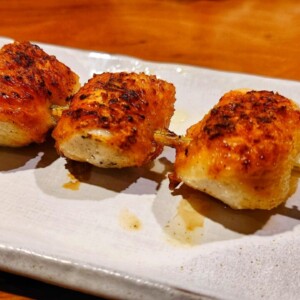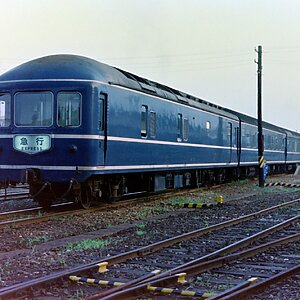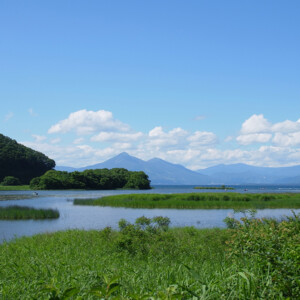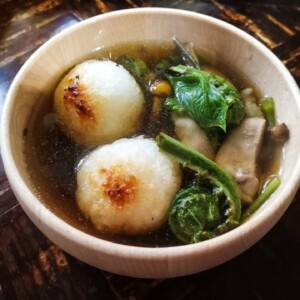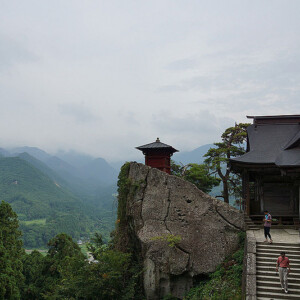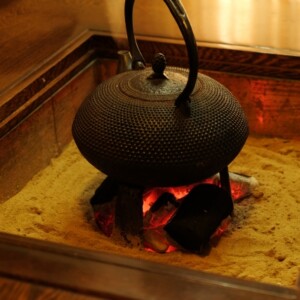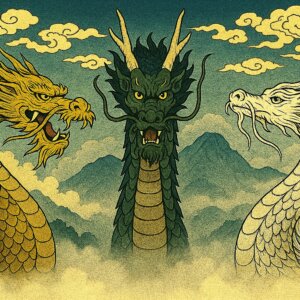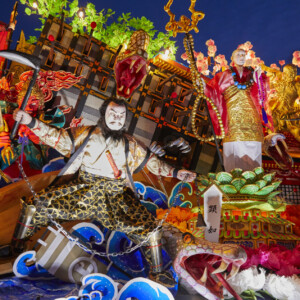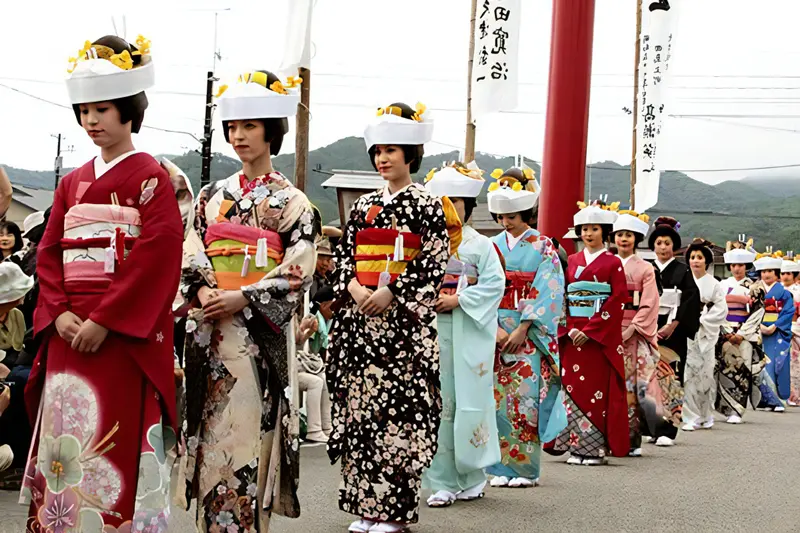
The Aizu Tajima Gion Festival is famous for Japan's number one bride line [Minami Aizu Town, Fukushima Prefecture]
table of contents
the ``Aizu Tajima Gion Festival'' , was once a bustling post town on the Shimotsuke Kaido (Aizu Nishi Kaido), which connected Nikko to Aizuwakamatsu, the center of the Aizu region.
Currently, the four towns and villages of Tajima Town, Tateiwa Village, Inan Village, and Nango Village merged into Minamiaizu Town in 2006, and the town hall is located in Tajima.
The place name Tajima is said to have been changed from the mythic period, as a god appeared on a small island in the rice fields in this area, and the name of the town that had previously been called Hinomachi was changed to "Tajima." People called this god "Tade Uga Daimyojin" and enshrined it as the main deity of Tade Uga Shrine,
“Aizu Tajima Gion Festival” started in the early Kamakura period
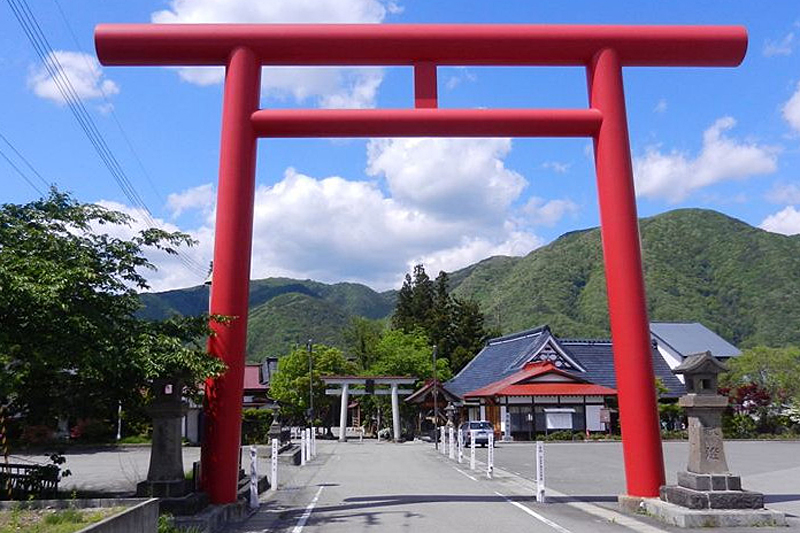
``Aizu Tajima Gion Festival'' is a festival held by Naganuma Munemasa, who was given Minami Aizu as a territory by Minamoto no Yoritomo during the Kamakura period. It is said that it started with the company.
Gion faith spread around Yasaka Shrine in Kyoto
“Gion Faith” is a faith that prayed to God to get rid of the plagues that frequently spread in Kyoto during the Heian period. People came to believe that by enshrining Susanoo-no-Mikoto (Susanoo-no-Mikoto), it would take the plague away with it.
The center of the faith is Yasaka Shrine in Kyoto, known as "Gion Shrine," which enshrines the main deity Sushoson. ), the guardian deity of Gion Shoja (an Indian temple where Buddha is said to have attended), which was enshrined at Yasaka Shrine (temple name: Kanjin-in), was also known as Gozu Tenno. It was believed that it could quell epidemics, just like Shunson.
The ritual to quell an epidemic is called Goryoe, and it is said that it evolved into the Gion Festival. Before you know it, Suhoson and the Indian god Gozu Tenno were worshiped as the same god, and even today, Gozu Tenno is the deity enshrined at the Gion Festival.
“Aizu Tajima Gion Festival” hosted by a party shop run by parishioners
The Aizu Tajima Gion Festival took on its current form during the Edo period, when it began to be held as a festival similar to the Gion Festival at Yasaka Shrine in Kyoto.
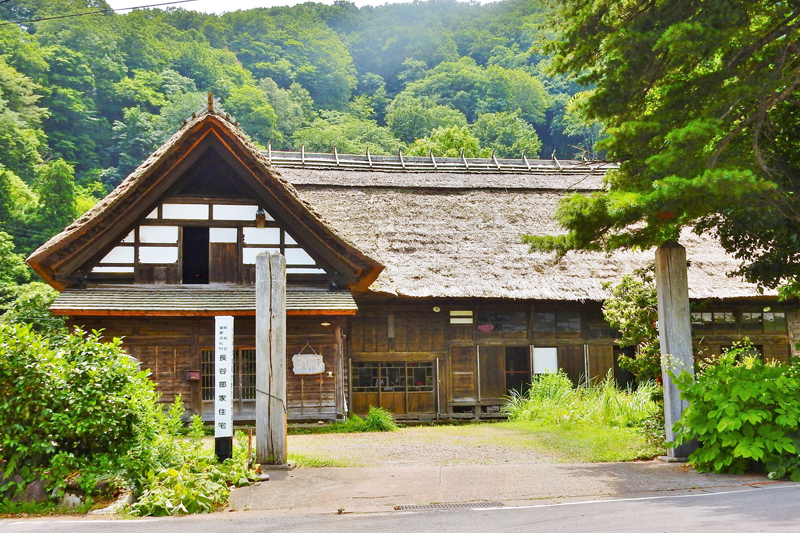
``Aizu Tajima Gion Festival'' is held on July 22nd every year as a joint annual festival of ``Tade Uga Shrine'' and ``Kumano Shrine'' whose main deity is Suhoson, which is co-located with ``Tade Uga Shrine''. It will be held for three days: Sunday, 23rd, and 24th.
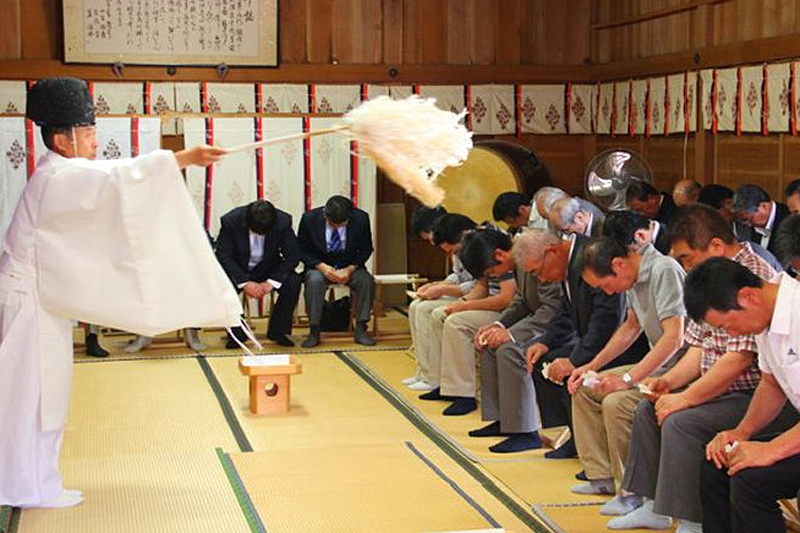
Shrine festivals are generally performed mainly by the chief priest, but the Tajima Gion Festival is not conducted by the chief priest, but by the parishioners. The parishioners form groups called "otoya" and take turns running the festival each year. There are currently 9 groups.
Doburoku is brewed at a shrine.
The party shop that is on duty that year begins preparations from January of the year the festival is held. It takes more than half a year until the day of the festival on July 22nd to perform various rituals such as purification, and to set up the shimenawa ropes, utensils, Shinto altars, and the sacred bridge (bridge where the gods pass).
Making special sacred sake (omiki) is also an important job of a party shop.

Currently, sake brewing is not possible without a national license, but in the case of the ``Aizu Tajima Gion Festival'', a sake brewing license has been granted to ``Tade Uga Shrine'' since the Meiji era, and Tajima's sake brewing company ``Kokugon Shuzo' ' It is created within the shrine with guidance and cooperation.
The sake produced is a cloudy white sake called ``Doburoku'', which is simply fermented by adding koji to steamed rice. This alcoholic beverage is served not only to those involved in the festival, but also to visitors, so the Aizu Tajima Gion Festival is also called the Doburoku Festival
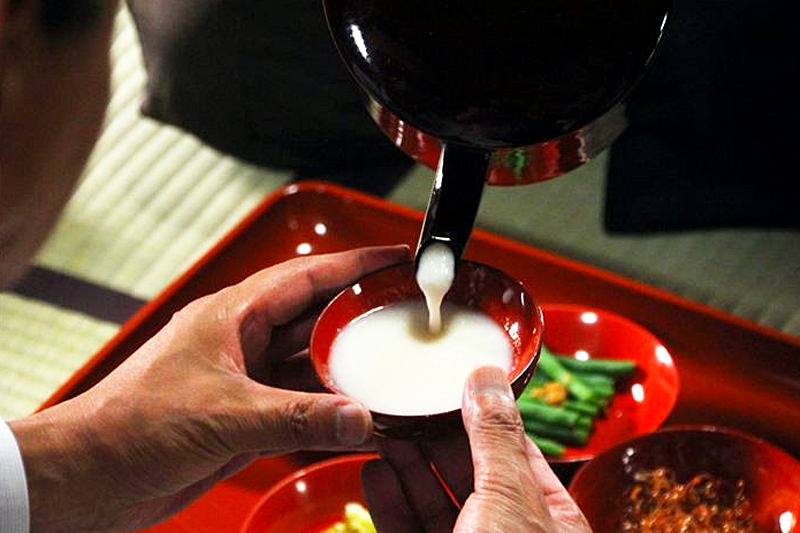
“Aizu Tajima Gion Festival” will be held for 3 days from July 22nd.
Day 1 (July 22nd)
“Children’s Kabuki” and Oyatai stalls being circulated around the town
The ``Aizu Tajima Gion Festival'' will be held at 10am on July 22nd, when all members of the party shop group will visit ``Tade Uga Shrine/Kumano Shrine'' wearing Edo period formal attire such as hakama and kamishimo. Let's start.
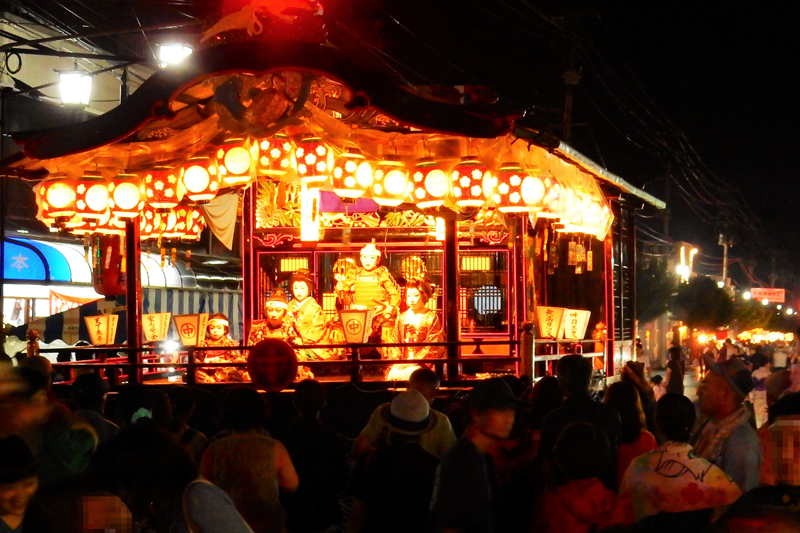
At 1:00 p.m., a children's kabuki performance will begin at the large stall. Oyatai are floats (dashi floats/dashi floats) that have a stage large enough to perform Kabuki.There are four of them, and over two days on the 22nd and 23rd, each Oyatai performs four times in the afternoon and evening, all with different programs. will be performed.
The performers in Kabuki are, of course, local children, who practice on a daily basis and are fully prepared for the festival.
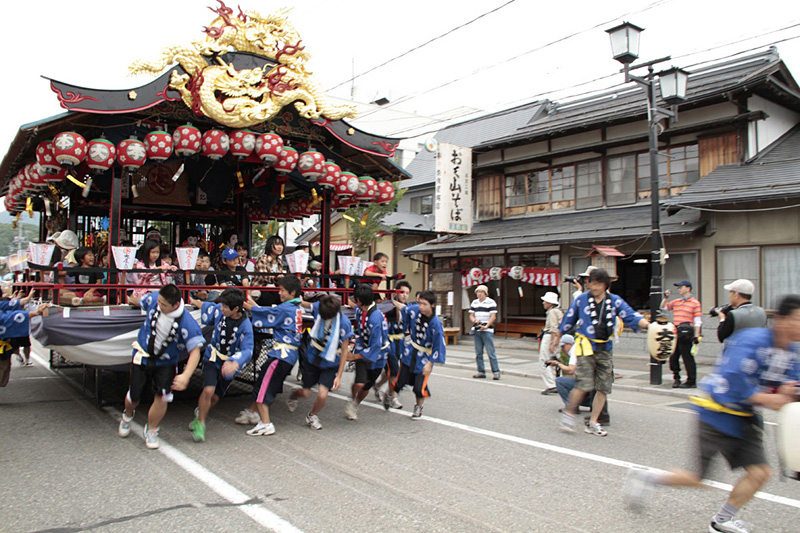
During times when Kabuki is not being performed, the large food stalls carry children around the town (food stall operation).
Day 2 (July 23rd)
The highlight of the second day is Japan's largest bride procession
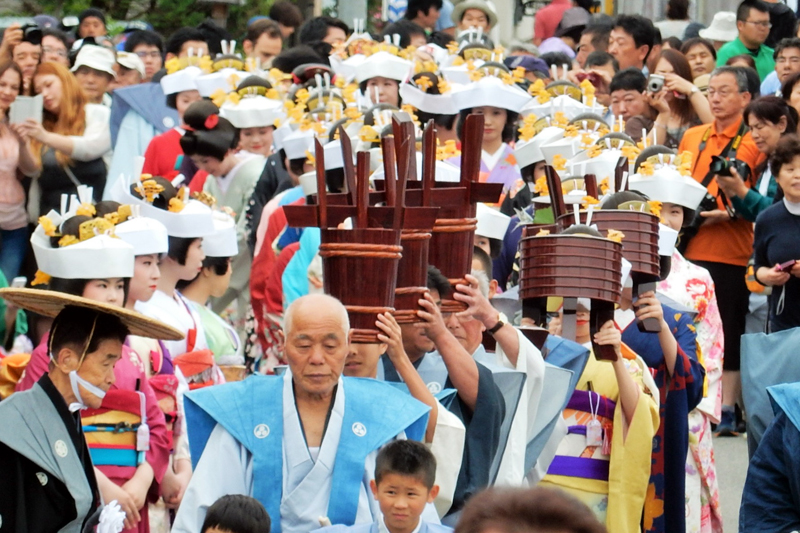
procession of the Aizu Tajima Gion Festival, the Nanaoui procession, will be held from 7:50 a.m. The ``Shichigyoki Procession'' is a procession in which people praying for the exodus of epidemics and a rich harvest, dedicate seven offerings to Gozu Tenno (Sushoson), and about 100 relatives and followers of Otoya-gumi go to the shrine. march toward
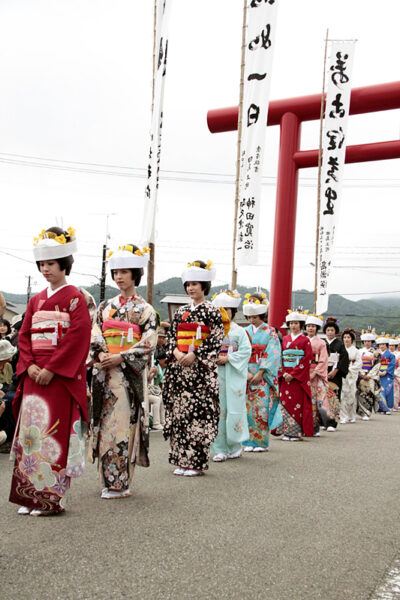
The vessel containing the offering is supposed to be held by a woman (unmarried) in formal attire, and after the seven-day procession, she is dressed in an Edo-period bridal style with her hair covered in a white cloth called Tsuno-kakushi. About 30 women join the procession, wearing long-sleeved kimonos and bunkin Takashimada tied in knots.
The procession of particularly gorgeous young women attracts many visitors as it is known as ``Japan's best bride procession.''
As a general rule, those who can participate in the bride procession are those related to the Otoya-gumi on duty, but if there are not enough people, people are recruited from the general public, including those from outside the prefecture.
Recruitment begins in early June, but you will need to check with the party shop that year to see if they will be recruiting. You can check the party shop on duty at the Minamiaizu Town Tourism and Products Association. You can rent a wig, kimono, obi, etc., and have your make-up and dressing done at a beauty salon in town.
Don't worry, it will cost you around 65,000 yen for the rental and make-up. Minamiaizu Town will provide a subsidy of up to 60,000 yen.
(Minamiaizu Town Aizu Tajima Gion Festival Shichigyoki Parade Bride Subsidy Grant Outline March 20, 2006 Notification No. 32) *Ordinances may change, so please check with Minamiaizu Town.
God rides on a mikoshi to exorcise the plague
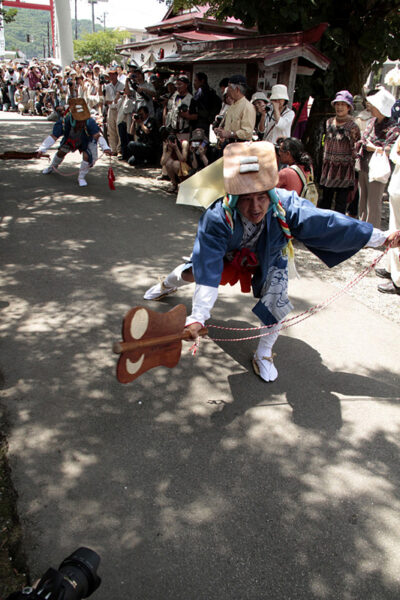
Starting at 10 a.m. on July 23rd, the deity to whom offerings have been made using the seven-lined vessel will be paraded through the town on a mikoshi (portable shrine) to exorcise epidemics and pray for a bountiful harvest. I pray (mikoshi togyo/mikoshi togyo).
There are two mikoshi, one for Tade Uga Shrine and one for Kumano Shrine, and a procession of dozens of people wearing costumes for various roles lead the mikoshi. The costumes worn by women are especially gorgeous. At the Otabisho (resting place for the mikoshi), the performers step in a roppo (an exaggerated walking style performed in Kabuki) and shout loudly, ``Let's get ready for the mikoshi.''
This "Mikoshi togyo" is also a highlight of the "Aizu Tajima Gion Festival".
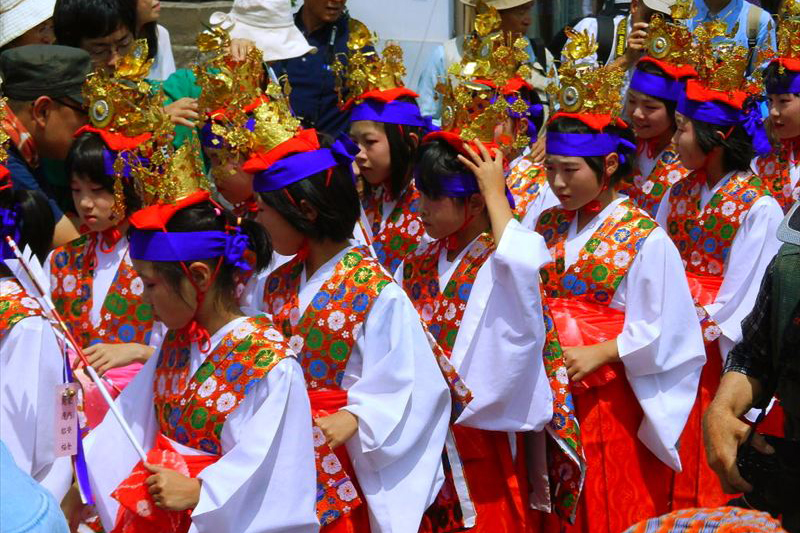
Day 3 (July 24th)
Kagura is performed and the curtain falls on the festival.
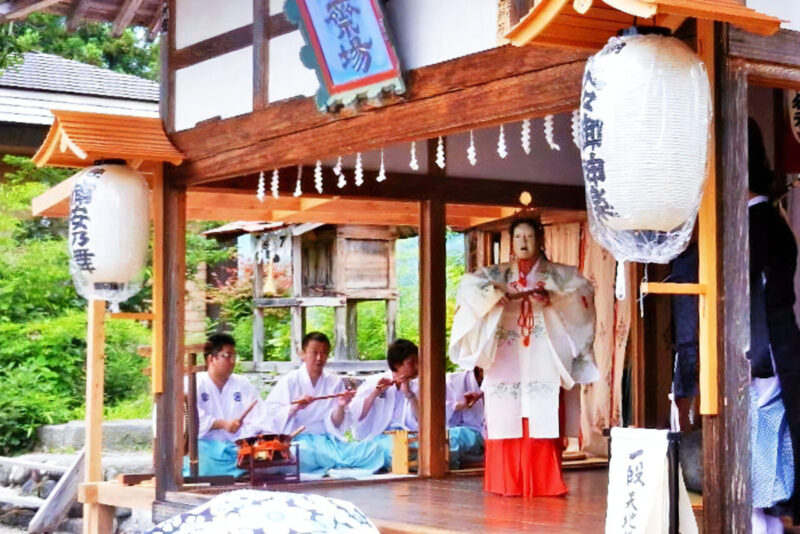
On July 24th, from 1:00 p.m., the traditional ``Dadaio Kagura'' will be performed at the Kagura Hall shared by both ``Tade Uga Shrine'' and ``Kumano Shrine'' to bring the festival to a close.
"Aizu Tajima Gion Festival" is a three-day festival that starts from July 22nd every year, and is counted as one of the three major Gion Festivals in Japan. However, due to the new coronavirus pandemic, from 2020 to 2022, there will be a parade of Public events have been cancelled. I look forward to seeing it after 2023.
The role of the party house in the Aizu Tajima Gion Festival, which begins in January and continues until the end of the festival, has been designated as a national important intangible folk cultural property as the Tajima Gion Festival Otoya Event.
Aizu Tajima Gion Festival <Information>
- Event period: July 22nd to July 24th
- Venue: Tajima-cho, Minamiaizu-cho, Fukushima Prefecture
- Contact: Minamiaizu Town Tourism Association
- Phone number: 0241-62-3000
- URL: Minamiaizu Town Tourism Association
Minamiaizu Town Aizu Tajima Gion Festival Shichigyoki Parade Bride Subsidy Grant Outline



![[Minamiaizu District, Fukushima Prefecture] The abundance of hot springs in the Nasu volcanic belt is attractive. ``Yunokami Onsen'' is a base for sightseeing in ``Ouchi-juku'' and ``Tanohetsuri.'' 22875645 m](https://jp.neft.asia/wp-content/uploads/2022/08/22875645_m-150x150.jpg)
![[Tenei Village, Fukushima Prefecture] Two hot spring inns with thatched roofs. ``Iwase Yumoto Onsen'' full of nostalgic atmosphere 1908-000](https://jp.neft.asia/wp-content/uploads/2022/08/1908-000-150x150.jpg)
![[Aizu Tajima Gion Festival Photo Report: Part 1] Kabuki Kabuki performances at the Great Hoods of the Night Festival [Minami Aizu Town, Fukushima Prefecture] 2025.07.22 Aizu Tajima Gion Festival_00](https://jp.neft.asia/wp-content/uploads/2025/07/PXL_20250722_105121018-150x150.jpg)
![[Aizu Tajima Gion Festival Photo Report: Part 2] Seven-lined procession, also known as Japan's number one bride procession [Minami Aizu Town, Fukushima Prefecture] 2025.07.22 Aizu Tajima Gion Festival_Japan's No. 1 Bride Procession](https://jp.neft.asia/wp-content/uploads/2025/07/IMG_38592-150x150.jpg)
![[Serialization: Following the narrow path in the back part 1] Your trip to Tohoku begins with "crossing the Shirakawa barrier" Oku no Hosomichi 1](https://jp.neft.asia/wp-content/uploads/2023/09/bf359c7fd6a5dbae7719b52ccd3b870b-1-150x150.jpg)
![Yamagata City, the foot of the Zao mountain range, is a treasure trove of Senbero Bars! [Yamagata Prefecture] Yamagata Senbero](https://jp.neft.asia/wp-content/uploads/2023/11/8668825a56f14e3e756ea2f8b268571e-150x150.jpg)
![[Recommended Autumn Festival: Fukushima Edition] Autumn in Fukushima is a warrior line and fight festival! Fukushima Catch](https://jp.neft.asia/wp-content/uploads/2024/08/cb34bf6367937424774a9fc363549068-150x150.jpg)
![[Fukushima Prefecture] Ouchi-juku, a post town that is full of Aizu's history and landscapes Ouchi-juku (miniature style)](https://jp.neft.asia/wp-content/uploads/2016/09/1686726_m-150x150.jpg)
